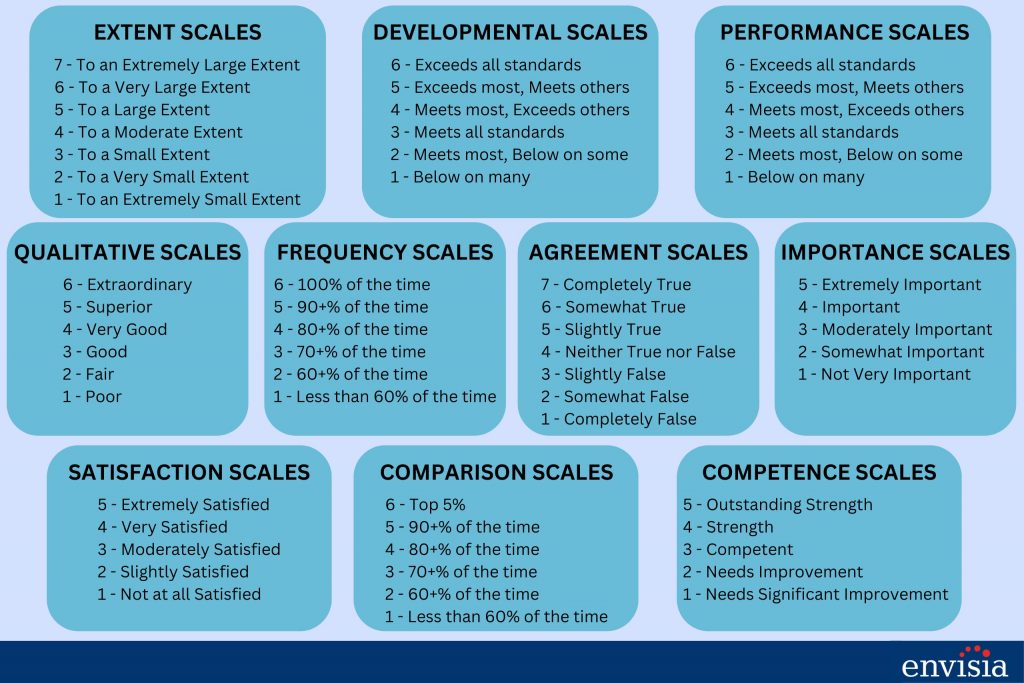Did you know that the effectiveness of a 360-degree feedback program hinges as much on the response scale as it does on the feedback itself? Selecting the right response scale is more than just a technical choice; it’s a strategic decision that can directly influence the quality of insights you gather. In this blog, we explore how the type of response scale impacts the success of feedback initiatives and provide actionable tips for choosing the best one for your organization.
Importance of Response Scales
The type of response scale you use in 360-degree feedback systems directly affects how useful and clear the feedback is. Research shows that some scales provide more reliable and actionable insights than others, making it essential to choose carefully.
When feedback lacks precision, it can lead to misinterpretation or even disengagement among employees. A well-designed response scale not only improves accuracy but also builds trust in the process, encouraging participants to provide honest and open feedback.

Frequency Scales vs. Effectiveness Scales
Frequency scales, such as those ranging from ‘never’ to ‘always,’ are common in feedback systems. However, they often receive criticism for being too general and not capturing nuanced behaviors. For instance, these scales might not fully reflect how impactful someone’s actions are.
Effectiveness scales shift the focus to the results of behaviors rather than how often they occur. For example, instead of asking “How often does this employee show leadership?” an effectiveness scale asks, “How effective is this employee at leading their team?” This approach often provides richer, more useful insights.
To choose the right scale for your organization, consider the goal of the feedback. Effectiveness scales might be better for development-focused feedback, while frequency scales could work for evaluating performance.
Social Comparison Scales
Social comparison scales measure performance relative to others, such as comparing an individual’s skills to their peers. These scales help reduce overly positive ratings in self-assessments, making feedback more balanced. Research supports this approach, showing that comparative judgments often align better with actual performance.
However, these scales need to be used carefully. While they can improve accuracy, they might also create unnecessary competition if not implemented thoughtfully. It’s important to explain to participants how the scales will be used to support development, not competition.
Frame of Reference Scales (FORS)
Frame of Reference Scales (FORS) incorporate specific behavioral examples into the rating scale, providing raters with a clearer understanding of each competency. Hoffman et al. (2012) found that FORS resulted in higher competency factor loadings and reduced measurement error, making them a promising option for enhancing feedback precision.
For example, instead of a generic question like “How well does this employee communicate?” a FORS include specific examples for each rating option, making it easier for participants to understand how to evaluate behaviors. For instance:
- “Rarely provides updates or clarifications.”
- “Consistently provides clear, concise, and timely communication.”
Using these clear examples ensures everyone interprets the scale the same way, reducing confusion and improving the accuracy of the feedback.

Cultural Sensitivity and Scaling
In multinational companies, the response scale must also consider cultural differences in behavior perception and evaluation. Holt and Seki (2012) suggest exploring scales that better align with varied cultural norms and expectations. For instance, cultures with indirect communication styles may benefit from scales that assess appropriateness rather than extremeness.
Additionally, language nuances should be considered. Direct translations of response scales might not capture the intended meaning in different languages, potentially skewing feedback. Collaborating with cultural experts during the design phase can mitigate these risks and ensure that the scales resonate globally.
Best Practices in Scale Selection
Choosing the most effective response scale requires a thoughtful approach tailored to your organization’s needs. Here are some best practices:
- Align with Objectives: Whether your feedback process is developmental or evaluative, the scale should reflect your primary goals. For instance, effectiveness scales may better support leadership development initiatives.
- Pilot Testing: Before full implementation, pilot test scales with a sample group to identify potential challenges or misinterpretations.
- Keep It Simple: Overly complex scales can confuse raters and compromise data quality. Ensure clarity by using straightforward language and examples.
- Relevance to Behavior: Ensure each scale option directly relates to the competencies being assessed. Avoid vague or overly broad categories that might lead to inconsistent ratings.
- Regular Review and Updates: Organizational needs evolve, and so should your feedback tools. Periodically review and refine your response scales to maintain their relevance and effectiveness.

Selecting the right response scale is more than a technical decision—it’s a strategic one that can significantly impact the success of your 360-degree feedback initiatives. By carefully considering the type of scale used and aligning it with organizational goals, you can greatly enhance the effectiveness and accuracy of your feedback processes.
Struggling with feedback accuracy? Partner with Envisia Learning to tailor your 360-degree feedback tools for maximum impact. Let’s elevate your leadership assessment strategy together.
